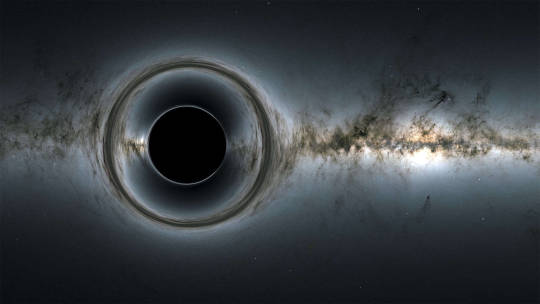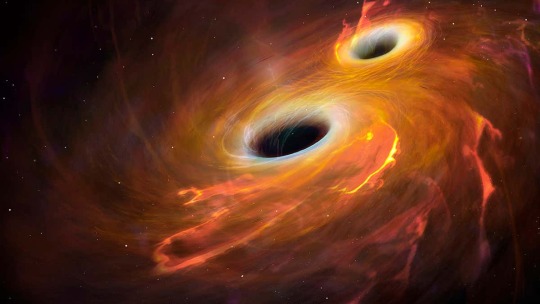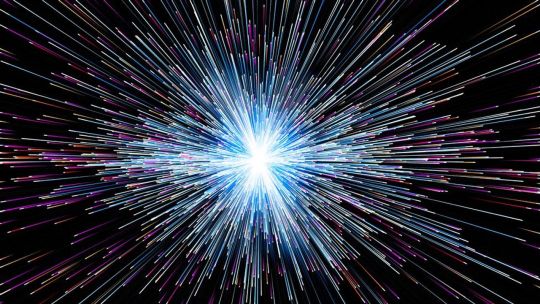Exploring space, one question at a time. Clear, science-based answers about black holes, NASA, and the universe for curious minds.
Don't wanna be here? Send us removal request.
Text
Black Holes and Dark Matter Is There a Hidden Connection?

Roughly 85% of the matter in the universe is invisible. It doesn’t emit, absorb, or reflect light. We call it dark matter, and we only know it exists because of the gravitational effects it has on galaxies and cosmic structures. But what is it really?
Some scientists believe the answer might lie in an unexpected place: black holes. Could these mysterious giants hold the key to understanding the equally elusive dark matter?
What Is Dark Matter?
Dark matter is a form of matter that doesn’t interact with electromagnetic radiation, meaning we can’t see it with telescopes. Yet it seems to exert gravitational influence on visible matter for example, it helps galaxies rotate faster than they should based on visible mass alone.
For decades, physicists have proposed particles like WIMPs (Weakly Interacting Massive Particles) or axions to explain dark matter. But none have yet been detected.
Primordial Black Holes as Dark Matter
One compelling theory suggests that primordial black holes, formed just moments after the Big Bang, could account for dark matter. These black holes would be small ranging from asteroid-size to stellar-mass and invisible to us, just like dark matter.
If enough of them existed, they could provide the gravitational pull we attribute to dark matter. Unlike theoretical particles, black holes are known to exist, making this idea especially attractive.
Evidence and Challenges Scientists have searched for signs of primordial black holes using:
Gravitational lensing: the bending of light caused by massive objects
Gravitational waves: ripples in spacetime from black hole mergers
Microlensing surveys: observing sudden brightness changes in stars
So far, the results have been inconclusive. While some data hints at the possibility of primordial black holes making up part of dark matter, other observations place tight limits on their abundance.
Are Supermassive Black Holes Related to Dark Matter?
There’s also speculation that the formation of supermassive black holes in the early universe could be linked to dark matter "halos" massive, invisible structures that help galaxies form.
In this view, dark matter and black holes don’t just coexist they co-evolve, influencing one another over billions of years.
While black holes and dark matter are among the greatest mysteries in cosmology, a deeper connection between them remains an open and exciting question. Whether through primordial black holes or cosmic evolution, black holes could be part of the solution to the dark matter puzzle.
As observational tools improve, we may be on the verge of connecting two of the universe’s most elusive phenomena and rewriting the story of how everything we know came to be.
1 note
·
View note
Text
The Future of Black Hole Research: What’s Next for Cosmic Exploration?

Black holes have long fascinated both scientists and the public. Once purely theoretical, they are now among the most studied yet still most mysterious objects in the cosmos. Thanks to advances in technology and theory, we're entering a new era of black hole research. So, what’s next?
In this final post of the series, we explore the future of black hole science and what discoveries may lie ahead.
1. Imaging Black Holes in Greater Detail The Event Horizon Telescope (EHT) gave us our first glimpse of a black hole’s shadow in 2019 and again in 2022 with the Milky Way’s Sagittarius A*. But that’s just the beginning. Future versions of the EHT, combined with space based telescopes, will produce higher resolution images, potentially revealing how black holes spin, feed, and evolve in real time.
2. Detecting Gravitational Waves Thanks to observatories like LIGO and Virgo, we can now detect ripples in spacetime caused by black hole mergers. Future missions like LISA (Laser Interferometer Space Antenna) will operate in space and be able to detect lower frequency waves, allowing us to study supermassive black holes and early-universe collisions with unprecedented detail.
3. Probing the Information Paradox One of the most mind bending questions in black hole physics remains: What happens to information that falls in? New developments in quantum gravity, string theory, and holographic principles are providing fresh approaches to this puzzle. Solving it could lead to a deeper understanding of the fundamental nature of space, time, and reality itself.
4. Searching for Primordial Black Holes Some scientists believe that primordial black holes formed shortly after the Big Bang could exist today and even account for dark matter. Upcoming sky surveys like LSST and Euclid may finally help locate these ancient remnants, opening a new chapter in cosmology.
5. Artificial Intelligence and Big Data The universe generates vast amounts of data. AI is increasingly being used to sift through telescope data to identify unusual black hole activity, binary systems, or merging events. As algorithms improve, we may uncover types of black holes we haven’t even imagined yet.
The future of black hole research is bright and full of mystery. With powerful new tools, cross disciplinary theories, and a growing international effort, we are on the verge of uncovering answers to some of the deepest questions in existence. The next few decades could change not just how we see black holes, but how we understand the entire universe.
Stay curious because in the realm of black holes, the unknown is just the beginning.
0 notes
Text
Hawking Radiation: Can Black Holes Actually Evaporate?

Black holes are known for being the ultimate traps nothing escapes their grasp, not even light. But what if that’s not entirely true? In the 1970s, physicist Stephen Hawking proposed a radical idea that challenged everything we thought we knew: black holes might not last forever. They might slowly evaporate.
What Is Hawking Radiation?
According to quantum mechanics, even the vacuum of space isn’t truly empty. It constantly generates tiny particle antiparticle pairs. Normally, these pairs annihilate each other instantly. But near a black hole’s event horizon, something strange can happen: one particle can fall into the black hole while the other escapes into space. The escaping particle becomes real energy Hawking radiation.
Why Is It Important?
This discovery implied that black holes could lose mass over time by emitting radiation. If they lose enough mass, they would eventually evaporate and disappear. This was revolutionary it meant black holes aren't eternal monsters. Instead, they’re slowly “leaking” energy back into the universe.
Small vs. Large Black Holes The radiation effect is incredibly tiny for large black holes, like the ones at the centers of galaxies. But for very small black holes perhaps ones formed during the early universe Hawking radiation could be intense, even explosive near the end of their life. Some scientists have speculated that such black holes could be responsible for mysterious high energy bursts in the cosmos.
The Information Paradox But there’s a twist. If black holes evaporate, what happens to the information about what fell in? Does it vanish too? That would violate quantum laws. This is the core of the black hole information paradox, a puzzle physicists are still trying to solve.
Hawking radiation changed our view of black holes forever. It turned them from eternal prisons into temporary, evolving entities. While we haven’t directly observed this radiation yet, the theory continues to guide some of the most exciting research in modern astrophysics.
2 notes
·
View notes
Text
Can We Break the Speed of Light? Could Einstein’s Limit Be Surpassed One Day?

Imagine this… Traveling from one galaxy to another in just seconds. Interstellar journeys, colonizing distant worlds, even time travel possible not in fiction, but in reality.
Science fiction writers have dreamed of this for decades. But for scientists, it’s not just a fantasy it’s a cosmic puzzle waiting to be solved.
In 1905, Albert Einstein introduced the theory of special relativity, which set the speed of light about 186,000 miles per second as the ultimate speed limit of the universe. According to this theory, no object or information can travel faster than light. But is this a universal rule? Or could it somehow be broken?
Why Is the Speed of Light a Limit?

Einstein’s theory tells us that the faster an object moves, the more energy it needs. And as it approaches the speed of light, its energy requirement becomes infinite.
That’s why nothing with mass no spaceship, no human can even reach the speed of light, let alone exceed it.
And it’s not just about energy time itself is affected: As an object gets closer to the speed of light, time slows down for it. This phenomenon is called time dilation. In theory, for something moving at light speed, time would stop completely. This raises serious questions about our ability to move forward in time.
So, Can Science Push This Limit?
Yes and this is where scientific imagination takes over. Here are a few ideas:
1. Warp Drive (Alcubierre Drive)
In 1994, physicist Miguel Alcubierre proposed a model that stretches Einstein’s equations by warping space itself. In this concept, the spaceship doesn’t move space does. Space compresses in front of the ship and expands behind it, allowing the vessel to reach its destination faster than light without breaking the speed limit locally.
The catch? It would require negative energy, an exotic form of matter that so far only exists in theory.
2. Wormholes
These black hole like structures could connect two distant parts of the universe like a tunnel. The idea: travel through space in a shortcut, not across it. But for a wormhole to be stable and traversable, you’d again need negative energy and serious advances in engineering and physics.
3. Tachyons (Ghost Particles)
Theoretically, some particles could naturally travel faster than light. We haven’t observed them, but if they exist, it could force us to rewrite the laws of physics. However, they would also challenge our understanding of causality and time travel.
So, Is It Truly Possible?
For now, faster than-light travel is beyond our reach. But that doesn’t mean it’s impossible forever.
Let’s not forget flying, going to the Moon, decoding DNA… all once seemed impossible. Science advances by challenging limits. With breakthroughs in physics, quantum fields, and our understanding of the universe, one day we may find a way to go faster than light.
What Do You Think? Is breaking the speed of light a real scientific goal or an unreachable boundary? Or… could there already be civilizations out there who’ve cracked the code?
Share your thoughts in the comments! After all, maybe the first step to unlocking the universe… starts with a single question.
0 notes
Text
Journey to the Beginning of the Universe: What We Know and Don’t Know About the Big Bang

Have you ever looked up at the sky and wondered, “How did it all begin?” One of humanity’s greatest questions is the origin of the universe. Stars, galaxies, time even space itself once didn’t exist. So how did everything come to be?
Scientists’ strongest answer to this question is the Big Bang Theory. But contrary to popular belief, this theory doesn’t describe an explosion of something it describes the expansion of space itself. And that changes our entire perspective of the universe.
The Big Bang: The Moment Everything Began
The Big Bang marks the known starting point of the universe. However, despite its name, it wasn't an "explosion" it was the expansion of space itself. The universe didn’t “blow up” from a point of matter; it expanded and gained dimension. Time, matter, energy, and even space itself emerged from this event.
What existed before the Big Bang?According to scientists, this question may have no answer because even the concept of “before” only makes sense after time itself began. If time started with the Big Bang, there technically was no “before.”
At the point where Einstein’s General Theory of Relativity meets modern quantum physics, the universe began with a singularity: a state of infinite density and zero volume. This is a moment when physical laws break down. That’s why science still holds great uncertainty about the universe’s “first moment.”
How Much Does Science Actually Know?
Today, existing data allows us to trace events that happened just seconds after the Big Bang. Here’s what we know about the formation of the universe:
1. Planck Time (10⁻⁴³ seconds) The very first moment of the universe. Quantum gravity dominates, and physical laws break down. Current physics cannot fully explain this era.
2. Cosmic Inflation (10⁻³⁶ to 10⁻³² seconds) The universe expands faster than the speed of light. During this brief phase, its size increases enormously. This theory explains why the universe is homogeneous and flat on large scales.
3. Birth of Fundamental Particles (10⁻⁶ seconds) The universe’s temperature is around a trillion Kelvin. Quarks, gluons, and leptons emerge.
4. Hadron Epoch (1 microsecond) Quarks combine to form protons and neutrons. The universe is a hot, dense plasma.
5. Lepton Epoch (1 second) Electrons and neutrinos dominate. Neutrinos decouple and move freely through space.
6. Nucleosynthesis (3–20 minutes) The universe cools enough for nuclear reactions. Hydrogen, helium, and lithium nuclei form though electrons still don’t orbit atoms.
7. Photon Decoupling (380,000 years) As the universe cools, electrons combine with protons to form atoms. Light is finally able to travel freely: this is the origin of the Cosmic Microwave Background (CMB). We can still detect this light with telescopes today.
8. First Stars and Galaxies (300 million years later) Gravity causes gas clouds to collapse, forming the first stars. These stars bring light and heavier elements. Galaxies form, and the universe begins to take shape.
What Remains Unknown?
What came before the Big Bang? Still unknown. The idea that time itself began may render this question meaningless.
What triggered the universe’s expansion? The cause of cosmic inflation remains uncertain. Was it quantum vacuum fluctuations? A collision with another universe?
What are dark matter and dark energy? These components are thought to make up 95% of the universe but their true nature is still a mystery.
The Universe’s Story Is Just Beginning…
The Big Bang marks not just the beginning of the universe but our own origins too.
The atoms in our bodies trace back to those early seconds. Every time we look up at the sky, we’re seeing our own history.
Yet many questions remain unanswered:Why does the universe exist at all? Could there be other universes? Is it possible to reverse time?
Perhaps the pursuit of such questions is the most human thing of all.
So, what do you think?
Is the Big Bang the beginning or just one part of a much larger cycle?What cosmic mystery fascinates you the most?
Share your thoughts in the comments.
14 notes
·
View notes